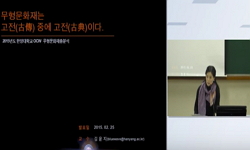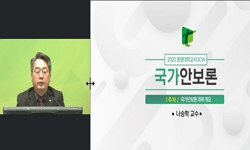Traditional culture could be succeeded or cut off depending on choices of the society’s members who enjoy that culture. It will not be no longer traditional culture if that culture is not and will not appreciated by current and future members of tha...
http://chineseinput.net/에서 pinyin(병음)방식으로 중국어를 변환할 수 있습니다.
변환된 중국어를 복사하여 사용하시면 됩니다.
- 中文 을 입력하시려면 zhongwen을 입력하시고 space를누르시면됩니다.
- 北京 을 입력하시려면 beijing을 입력하시고 space를 누르시면 됩니다.

대한민국 전통문화산업 관련 법제도 고찰 = A Study on Legal System regarding Traditional Culture Industry of the Republic of Korea
한글로보기부가정보
다국어 초록 (Multilingual Abstract)
This paper studies the trends of laws and policies of the Republic of Korea regarding the traditional culture industry. The viewpoints of the society regarding traditional culture industry could be reviewed as the laws are registered consensus of members of that society. And the policies of the government are important ways to discover, to preserve and to utilize the value of culture to execute with governmental authority. Tradition has been set up naturally by life styles through historical and social standard norms and natural environment. This paper defines the chronologic time of traditional cultural industry by modern times and the before.
The Cultural Heritage Protection Act, legislated in 1962, emphasized the protection of the cultural properties. The Cultural Heritage Protection Fund Act, legislated in 2009, is also a law to preserve and protect the cultural properties. In 2011, the scope of the intangible cultural heritage was extended from the area of special experts to the area of mass public activities, such as ‘play’ and ‘ceremony’. In 2014, through the amendment of The Cultural Heritage Protection Act, legal grounds were set up for cultural properties utilization and business opportunities. The Intangible Cultural Heritage Preservation and Promotion Act, legislated in 2015 and being executed in 2016, was split from The Cultural Heritage Protection Act. By this split of the laws, it is possible to respond to the demands of international society, such as UNESCO. Aslo, The Cultural Heritage Protection Act extended the scope of intangible cultural heritage wider. New definition of the intangible cultural heritage includes (a) traditional performance and arts (b) traditional skills about craft and art works (c) traditional knowledge about oriental medicine, agriculture and fishery (d) oral tradition and expression (e) traditional living habits including food, clothing, and shelter (f) civil ceremony including folk religion (g) traditional play, festival, accomplishments and martial arts. The Intangible Cultural Heritage Preservation and Promotion Act makes it available to establish and operate ‘Traditional Craft Bank’ which can buy, rent and display the traditional crafts created by traditional masters. Also, it encourages government to promote traditional performance and traditional arts for display and marketing activities overseas through the cooperation with international organizations and other countries.
Even though craft cultural industry is one of the highly value-added business as it could be melded with other industries, the business activities of traditional craft cultural industry were not strongly supported and encouraged by the law. The Craft Cultural Industry Promotion Act, legislated in 2015, made it possible to execute promotional policy for melding tradition and modern, grafting arts onto business legally. The Craft Cultural Industry Promotion Act encourages central and regional governments to make comprehensive plans for a craft cultural industry promotion including research and study for a craft cultural industry promotion, business foundation and production aid, infrastructure expansion and sales distribution vitalizations. This Act requires government (a) providing fund loan to business founders f...
Traditional culture could be succeeded or cut off depending on choices of the society’s members who enjoy that culture. It will not be no longer traditional culture if that culture is not and will not appreciated by current and future members of that society, even though that culture had been highly appreciated and enjoyed by past members of that society. That culture could be perished if members of that society do not cherish the value of that culture any more. However, if that culture had been cut off by artificial interruption of outsiders, some ways must be studied to discover, to preserve and to utilize the value of that traditional culture for next generations of that society.
This paper studies the trends of laws and policies of the Republic of Korea regarding the traditional culture industry. The viewpoints of the society regarding traditional culture industry could be reviewed as the laws are registered consensus of members of that society. And the policies of the government are important ways to discover, to preserve and to utilize the value of culture to execute with governmental authority. Tradition has been set up naturally by life styles through historical and social standard norms and natural environment. This paper defines the chronologic time of traditional cultural industry by modern times and the before.
The Cultural Heritage Protection Act, legislated in 1962, emphasized the protection of the cultural properties. The Cultural Heritage Protection Fund Act, legislated in 2009, is also a law to preserve and protect the cultural properties. In 2011, the scope of the intangible cultural heritage was extended from the area of special experts to the area of mass public activities, such as ‘play’ and ‘ceremony’. In 2014, through the amendment of The Cultural Heritage Protection Act, legal grounds were set up for cultural properties utilization and business opportunities. The Intangible Cultural Heritage Preservation and Promotion Act, legislated in 2015 and being executed in 2016, was split from The Cultural Heritage Protection Act. By this split of the laws, it is possible to respond to the demands of international society, such as UNESCO. Aslo, The Cultural Heritage Protection Act extended the scope of intangible cultural heritage wider. New definition of the intangible cultural heritage includes (a) traditional performance and arts (b) traditional skills about craft and art works (c) traditional knowledge about oriental medicine, agriculture and fishery (d) oral tradition and expression (e) traditional living habits including food, clothing, and shelter (f) civil ceremony including folk religion (g) traditional play, festival, accomplishments and martial arts. The Intangible Cultural Heritage Preservation and Promotion Act makes it available to establish and operate ‘Traditional Craft Bank’ which can buy, rent and display the traditional crafts created by traditional masters. Also, it encourages government to promote traditional performance and traditional arts for display and marketing activities overseas through the cooperation with international organizations and other countries.
Even though craft cultural industry is one of the highly value-added business as it could be melded with other industries, the business activities of traditional craft cultural industry were not strongly supported and encouraged by the law. The Craft Cultural Industry Promotion Act, legislated in 2015, made it possible to execute promotional policy for melding tradition and modern, grafting arts onto business legally. The Craft Cultural Industry Promotion Act encourages central and regional governments to make comprehensive plans for a craft cultural industry promotion including research and study for a craft cultural industry promotion, business foundation and production aid, infrastructure expansion and sales distribution vitalizations. This Act requires government (a) providing fund loan to business founders f...
참고문헌 (Reference)
1 "해외문화홍보원 누리집"
2 문화관광부, "한스타일 육성종합계획" 2007
3 "한국공예 디자인문화진흥원 누리집"
4 김시범, "지역 문화유산을 활용한 문화콘텐츠사업화 방향에 대한 담론" 인문콘텐츠학회 (27) : 171-180, 2012
5 "제45회 대한민국공예품대전 누리집"
6 고해은, "전통문화의 현대화를 위한 아이덴티티 디자인 연구 : 화경당 사례연구를 중심으로" 서울대학교 대학원 2012
7 심광호, "전통문화산업정책에 대한 재음미: “그물망”으로서의 정책과정과 그 “뒤얽힘”에 대한 탐색적 연구" 한국정부학회 26 (26): 735-768, 2014
8 문화체육관광부, "전통문화산업육성진흥방안 연구" 2011
9 문화체육관광부, "전통문화산업 실태조사 및 종합육성계획 수립을 위한 기초연구" 2010
10 서연호, "전통문화 대중화를 위한 새로운 지평" 문화체육관광부 2015
1 "해외문화홍보원 누리집"
2 문화관광부, "한스타일 육성종합계획" 2007
3 "한국공예 디자인문화진흥원 누리집"
4 김시범, "지역 문화유산을 활용한 문화콘텐츠사업화 방향에 대한 담론" 인문콘텐츠학회 (27) : 171-180, 2012
5 "제45회 대한민국공예품대전 누리집"
6 고해은, "전통문화의 현대화를 위한 아이덴티티 디자인 연구 : 화경당 사례연구를 중심으로" 서울대학교 대학원 2012
7 심광호, "전통문화산업정책에 대한 재음미: “그물망”으로서의 정책과정과 그 “뒤얽힘”에 대한 탐색적 연구" 한국정부학회 26 (26): 735-768, 2014
8 문화체육관광부, "전통문화산업육성진흥방안 연구" 2011
9 문화체육관광부, "전통문화산업 실태조사 및 종합육성계획 수립을 위한 기초연구" 2010
10 서연호, "전통문화 대중화를 위한 새로운 지평" 문화체육관광부 2015
11 "우수공예상품 지정표시제 도자공예부문 공모요강"
12 김선혜, "역사문화자원의 콘텐츠 활용방안 연구 : 역사인물 정조를 중심으로" 한국외국어대학교 대학원 2012
13 유동환, "새로운 전통문화 종합계획 방향 제안" 문화체육관광부 (서울:국립민속박물관 강당) 2015
14 문화체육관광부 누리집, "문화체육관광부 보도자료"
15 "문화재보호법 시행령"
16 "문화재보호법 시행규칙"
17 "문화재보호법"
18 "문화재보호기금법"
19 "무형문화재 보전 및 진흥에 관한 법률"
20 국가법령정보센터, "누리집"
21 "공예문화산업진흥법"
22 정갑영, "21세기를 향한 우리나라 전통문화정책의방향과 과제" 7 : 103-123, 1995
동일학술지(권/호) 다른 논문
-
- 아시아.유럽미래학회
- 김태우
- 2016
- KCI등재
-
데이터마이닝을 활용한 인구집단 구성과 경제적 불평등 평가
- 아시아.유럽미래학회
- 민대기
- 2016
- KCI등재
-
- 아시아.유럽미래학회
- 이은애
- 2016
- KCI등재
-
개방경제하에서 거시경제변수가 경제성장에 미치는 효과 분석
- 아시아.유럽미래학회
- 김성순
- 2016
- KCI등재
분석정보
인용정보 인용지수 설명보기
학술지 이력
| 연월일 | 이력구분 | 이력상세 | 등재구분 |
|---|---|---|---|
| 2022 | 평가예정 | 재인증평가 신청대상 (재인증) | |
| 2019-01-01 | 평가 | 등재학술지 유지 (계속평가) |  |
| 2016-01-01 | 평가 | 등재학술지 유지 (계속평가) |  |
| 2012-01-01 | 평가 | 등재학술지 선정 (등재후보2차) |  |
| 2011-01-01 | 평가 | 등재후보 1차 PASS (등재후보1차) |  |
| 2009-01-01 | 평가 | 등재후보학술지 선정 (신규평가) |  |
학술지 인용정보
| 기준연도 | WOS-KCI 통합IF(2년) | KCIF(2년) | KCIF(3년) |
|---|---|---|---|
| 2016 | 0.55 | 0.55 | 0.47 |
| KCIF(4년) | KCIF(5년) | 중심성지수(3년) | 즉시성지수 |
| 0.47 | 0.46 | 0.727 | 0.13 |




 KCI
KCI 스콜라
스콜라






